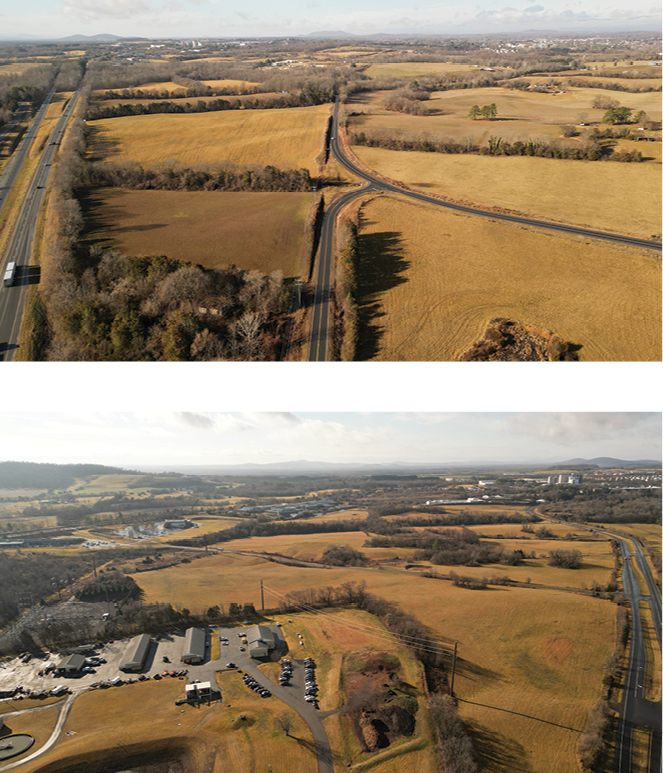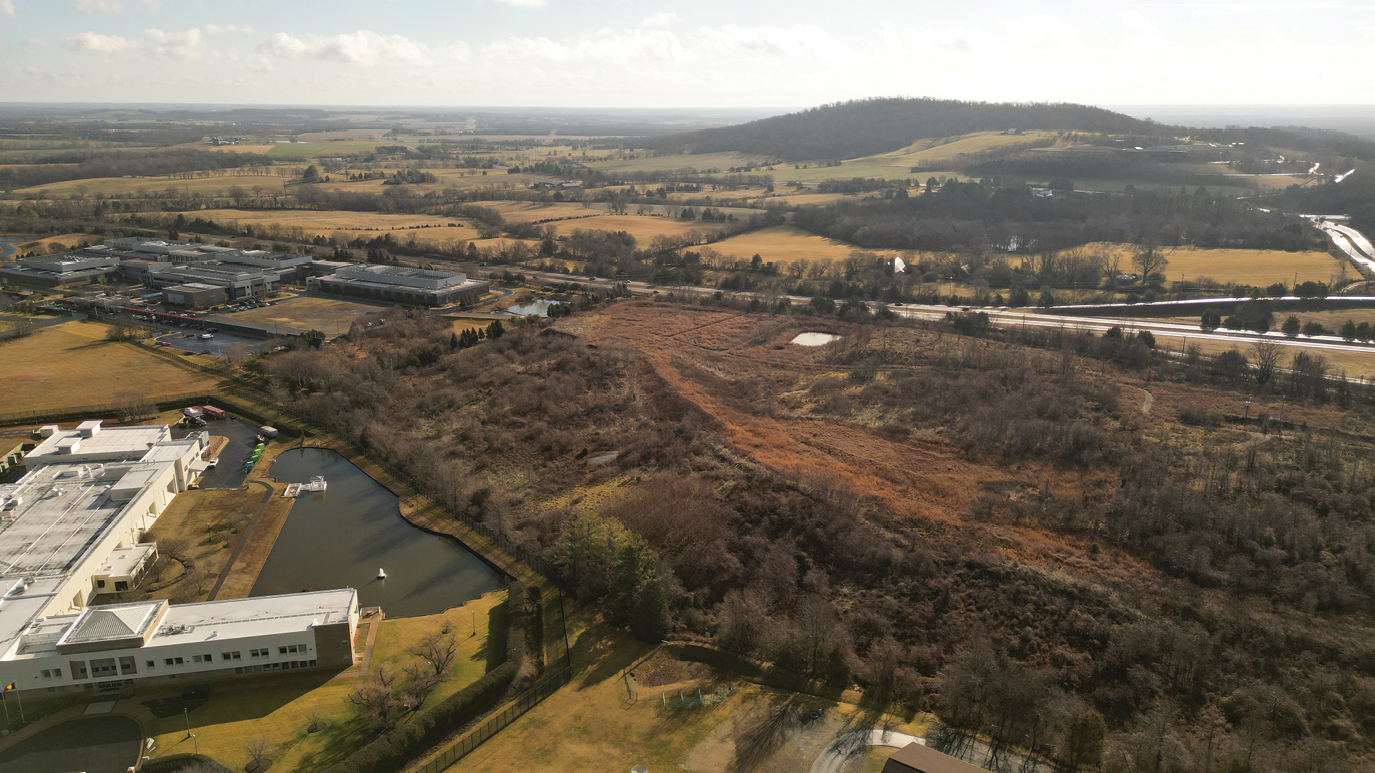Pastoral places that used to host horse farms and tractor pulls will soon power the artificial intelligence we use for everything from streaming services to driverless cars.
That is because AI requires real infrastructure, and the capital investment needed to build that infrastructure does not come cheap.
Newmark, in its 2023 U.S. Data Center Market Overview released in January 2024, attempted to quantify the impact of AI on data center investment — and the results are staggering. The top five hyperscalers spent $158 billion on data centers in 2022, led by Amazon’s $64 billion, Google’s $32 billion, and Meta’s $31 billion. Microsoft chipped in $25 billion, while Oracle added $6 billion. Just five years earlier, these same five firms spent a combined $42 billion.

Data Bank (Lead Image), Cielo Digital (TOP), and CloudHQ (BOTTOM) sites in Culpeper County, Virginia.
Photos courtesy of Culpeper County Economic Development
“Cloud capex for top hyperscalers has grown by 30% CAGR over the last five years,” Newmark states. “AI’s impact on the data center industry is still in very early innings. On a macro scale, data center demand in the U.S. is expected to reach 35 GW by 2030, up from 17 GW in 2022.”
In other words, data center demand in the U.S. will double over the next six years; and implementation of AI applications will be at the core of that demand. At their current rate of expansion, hyperscalers will top $1 trillion in spending on new facilities by 2030.
While Tier 1 markets like Northern Virginia, Chicago, Atlanta and Dallas will continue to rake in sizable investments, a new player has emerged on the scene: green acres.
Recent project announcements shed light on this trend. Amazon Web Services (AWS), the sector’s biggest spender, is investing $35 billion into new data center infrastructure throughout Virginia, with the bulk of that going to the state’s interior counties. AWS also announced that it plans to spend $10 billion to construct two data center campuses in Madison County, Mississippi, near the capital of Jackson.
Meta announced February 2 that it plans to invest $37 billion to expand its digital infrastructure this year. Two of the company’s largest projects are in Kuna, Idaho, and Temple, Texas. Meta and AWS are spending billions to erect new data center campuses in Central Ohio, joining companies like Google and Microsoft in that exclusive billionaires’ club.
Microsoft has submitted plans to build up to $10 billion in new data center campuses on two sites in New Albany, Ohio, while Google will soon top $3.7 billion in spending on campuses in Columbus, New Albany and Lancaster.
Other mega-deals in 2024 include Google’s $600 million project in Wasco County, Oregon, and a $220 million campus for QTS in Fort Worth, Texas.
Byte Handlers Are Buying the Farm
Increasingly, these projects are entering parts of America that have never seen digital infrastructure spending of this scale.
Case in point is Culpeper County, Virginia, 90 minutes south of Washington, D.C. Cielo Digital has received approval to build a 1.4-million-sq.-ft. data center campus on 121 acres in a rural pasture that is being rezoned as part of the county’s McDevitt Drive Technology Zone.
According to plans submitted by Cielo, the company could invest as much as $7.5 billion over the next three to five years to build the campus and install equipment.
Cielo has company. CloudHQ will deliver a 2.1-million-sq.-ft. campus on 95 acres in Culpeper County in 2025, taking 275 MW of IT load power. It will be just 1,000 feet from the Network Access Point (NAP) of the Capital Region even though it is 65 miles from the nation’s capital.
For a rural farming community of 52,552 people, investments like these are game-changing for the local economy, says Bryan Rothamel, director of Culpeper County Economic Development.
“We have actively courted data centers, and we have won them,” says Rothamel. “We have seen almost 10 million square feet of approved data center space in the past two years. Cielo is our latest one and perhaps our last one in our incentivized area. I worked with the company over the past year to find a property.”
Rothamel says that even though Culpeper is remote, “we are only an hour south of Dulles International Airport, and U.S. Highway 29 goes through our county.” He adds that “this is not our first data center. Equinix built a data center here in 2008, and SWIFT operates one of its three data centers in the world here.”
SWIFT stands for the Society for Worldwide Interbank Financial Telecommunications. It is operated by a Belgian company for the purpose of executing financial transactions and payments between banks worldwide.
From Cows to Carbon-Neutral Assets
Brent Mayo, executive managing director of data center and digital infrastructure capital markets at Newmark, says that remote locations like Culpeper will become the norm as cloud hyperscalers scout virgin territory for their massive projects.
“We anticipate more nascent markets to expand rapidly in the coming years, driven by power availability and deliverability,” says Mayo. “Latency-sensitive and latency-non-sensitive data centers bifurcate the market. We expect that trend to continue, like what Amazon is doing in Mississippi. Demand is being driven by applications in the evolving world of AI and the highest power requirements. Power costs and operating costs are driving users to cheaper and more remote locations.”
These projects will demand rapid deployment of energy infrastructure, says Mayo. “On both power and cooling, you are going to see new sources deployed,” he notes. “The grid is under significant strain and new supply is slowed. You will see more generation assets developed. They also must meet the carbon reduction goals of these companies. Solar, wind and hydroelectric power supported by battery storage will be adopted in coming years.”
Emerging markets to watch, he says, include Columbus, Charlotte, Nashville and Minneapolis. “This unprecedented demand is shaped by power availability,” he adds. “The grid is getting constrained. What we know for sure is that we will need more carbon-neutral assets.”

